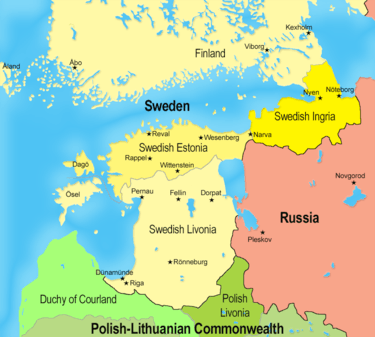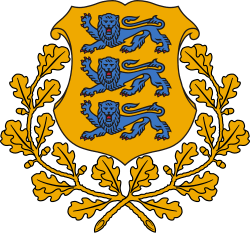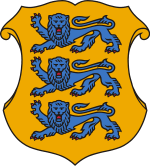Duchy of Estonia (1561–1721)
| Duchy of Estonia | ||||||
| Hertigdömet Estland | ||||||
| Dominion of Swedish Empire | ||||||
| ||||||
| ||||||
 Baltic provinces of Swedish Empire in the 17th century. | ||||||
| Capital | Reval | |||||
| Languages | German, Estonian, Swedish | |||||
| Religion | Lutheranism | |||||
| Government | Dominion | |||||
| Governor-General | ||||||
| - | 1674–1681 | Anders Torstenson | ||||
| - | 1687–1704 | Axel Julius De la Gardie | ||||
| History | ||||||
| - | Established | June 4, 1561 | ||||
| - | Treaty of Nystad | September 10, 1721 | ||||
Part of a series on the |
|---|
| History of Estonia |
 |
|
Viking and Middle ages |
|
Modern Estonia |
| Chronology |
| Estonia portal |
_en2.png)
The Duchy of Estonia (Swedish: Hertigdömet Estland, Estonian: Eestimaa hertsogkond, German: Herzogtum Estland), also known as Swedish Estonia,[1] (Swedish: Svenska Estland) was a dominion of the Swedish Empire from 1561 until 1721, when it was ceded to Russia in the Treaty of Nystad, following its capitulation, during the plague, in the Great Northern War.
The dominion arose during the Livonian War, when the northern parts of present-day Estonia (Reval (Tallinn) and the counties of Harjumaa, Western Virumaa, Raplamaa and Järvamaa) submitted to the Swedish king in 1561, and Läänemaa in 1581. It is also colloquially known as the "good old Swedish times"[2] (Estonian: vana hea Rootsi aeg) by Estonians, but this expression was not used before the following Russian rule, in the beginning of which the situation of Estonian peasantry declined rapidly (to gain support of German nobility, Russia gave them more power over peasantry).
Head of Dominion
- Governors (1561–1674)
- Lars Ivarsson Fleming Friherre of Nynäs, from Sundholm (August 2, 1561 – February 27, 1562)
- Klaus Christiern Horn of Åminne (acting) (August 1561)
- Henrik Klasson Horn from Kankas (1st time) (February 27, 1562 – June 1562)
- Svante Stensson Sture (June 30, 1562 – July 27, 1564)
- Hermann Pedersson Fleming from Lechtis (1564–1565)
- Henrik Klasson Horn from Kankas (2nd time) (January 30, 1565 – 1568)
- Gabriel Kristiernsson Oxenstierna from Mörby (November 1568 – 1570)
- Hans Björnsson from Lepas (October 9, 1570 – 1572)
- Claes Åkeson Tott (November 6, 1572 – 1574)
- Pontus De la Gardie (June 4, 1574 – December 1575)
- Karl Henriksson Horn from Kankas (1st time) (January 1576 – May 1578)
- Nilsson Hans Eriksson Finn from Brinkala (acting) (April 19, 1576 – 1577)
- Göran Boije af Gennäs (1st time) (August 1, 1577 – 1580)
- Svante Eriksson Stålarm from Kyala (1580–1581)
- Göran Boije af Gennäs (2nd time) (April 25, 1582 – 1583)
- Pontus De la Gardie (1583 – November 5, 1585)
- Gustaf Gabrielsson Oxenstierna (November 8, 1585 – 1588)
- Hans Wachtmeister (acting) (July 1588 – October 13, 1588)
- Gustaf Axelsson Banér from Djurshom (October 13, 1588 – 1590)
- Erik Gabrielsson Oxenstierna af Lindö (1590 – July 1592)
- Göran Boije af Gennäs (3rd time) (1592 – June 1600)
- Karl Henriksson Horn from Kankas (2nd time) (acting) (1600 – January 30, 1601)
- Moritz Stensson Leijonhufvud Count of Raseborg (1601 – October 1602)
- ... (October 1602 – May 1605)
- Nils Turesson Bielke (May 10, 1605 – June 1605)
- Axel Nilsson Ryning (1605–1608)
- ... (1608–1611)
- Gabriel Bengtsson Oxenstierna (1611–1617)
- Anders Eriksson Hästehufvud (1617–1619)
- Jakob De la Gardie (July 1619 – 1622)
- Per Gustafsson Banér af Tussa (1622 – January 1626)
- Johan De la Gardie Friherre of Eckholm (1626 – October 1628)
- Philipp Scheiding from Arnö (1628 – July 17, 1642)
- Gustaf Gabrielsson Oxenstierna Friherre of Kimito (July 26, 1642 – 1646)
- Erik Axelsson Oxenstierna, Count of Södermöre (September 9, 1646 – 1653)
- Wilhelm Ulrich (1st time) (acting) (May 1653 – August 16, 1653)
- Heinrich von Thurn-Valsassina, Count of Thurn (August 16, 1653 – 1655)
- Wilhelm Ulrich (2nd time) (acting) (1655 – August 1655)
- Bengt Skytte (1655–1656)
- Wilhelm Ulrich (3rd time) (acting) (1655– August 2, 1656)
- Bengt Klasson Horn (August 2, 1656 – November 1674)
- Wilhelm Ulrich (4th time) (acting) (1656–1659)
- Johan Christoph Scheiding (acting) (1674)
- Governors-General (1674–1728)
- Andreas Lennartson Torstensson (1674–1681)
- Robert Johannson Lichton (April 1681 – 1687)
- Nils Turesson Bielke (January 20, 1687 – April 19, 1687)
- Axel Julius De la Gardie from Läckö Castle, Lidköping (1687 – December 1704)
- Wolmar Anton von Schlippenbach (December 1704 – July 6, 1706)
- Niels Jonsson Stromberg af Clastorp (July 6, 1706 – October 23, 1709)
- Carl Nieroth (October 23, 1709 – October 10, 1710)
 |
See also
- Estonia under Swedish rule
- Dominium maris baltici
- Dominions of Sweden
- Swedish Livonia
- Estonian Swedes
- Governorate of Estonia
- Uniformity policy
Additional information
References
Sources
- Tarkiainen, Kari; Tarkiainen, Ülle (2013). Provinsen bortom havet. Estlands svenska historia 1561-1710 (in Swedish). Atlantis. ISBN 978-91-7353-652-3.
- Online encyclopedia – WorldStatesmen.org

